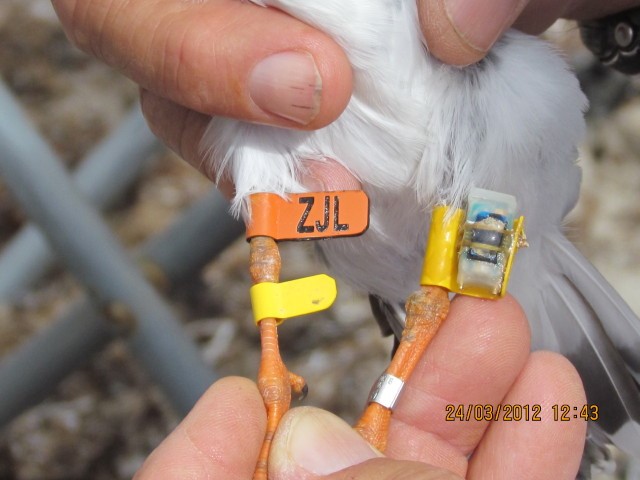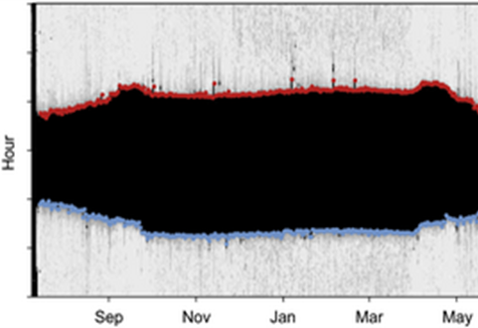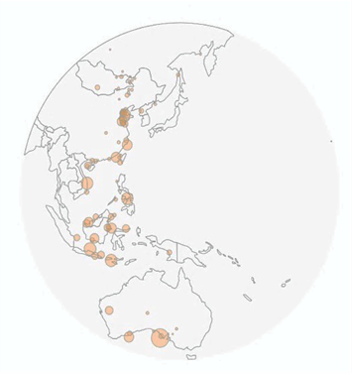Geolocator Studies
The Victorian Wader Studies Group were among the first to embark on the use of geolocators for the study of movements of migratory species of shorebirds from Australia. The geolocator program, commenced in Australia by the VWSG in 2009, has provided insights into many of the strategies and outcomes of the species studied.
Click on the tiles below to read a summary of individual species geolocator work.
What is a geolocator?
A geolocator is a small device we place on a bird that allows us to understand where it goes. The light weight of a geolocator makes it ideal for small waders as satellite tracking devices are too large for these birds. Over recent years, we have adopted Intigeo-W65 geolocators, supplied by Migrate Technology Ltd, Cambridge, UK. The units contain a battery, memory chip and an accurate clock.
The units are mounted on plastic leg-flags (made from a Darvic PVC sheet) using Kevlar thread reinforced with Araldite resin cement. See below. It is mounted vertically on the flag and attached to the leg of the bird.

The geolocator unit generally used weighs 0.65g, although for small waders like Red-necked Stint we use a 0.3g unit. (Figure 2). All units are deployed on adult birds which are captured using cannon nets.
Importantly, because it is an archival tracking devices (i.e. data is saved onto the device), to obtain the data, the loggers must be retrieved to download the data archive. Therefore, it is important that we only use these devices on birds or populations with high site fidelity at wintering, breeding or stopover locations.
How does a geolocator work?
The basic premise is that geolocators record light and dark. Light level geolocation is the method of recording ambient light levels to establish geographical location using astronomical algorithms.
Other information such as temperature and conductivity can help with both activity studies and to aid location determination e.g. for shorebirds, when the conductivity sensor indicates significant seawater then the bird is on the coast.
The accuracy of light level geolocation is appreciably less than satellite or GPS devices, but it is sufficient to provide large-scale movement and detailed timing data as well as to identify important stopover areas and connectivity relating to the bird’s migration. Importantly these loggers are considerably cheaper.

Data recorded by a geolocator – light and darkness 
Detailed migration route of birds
How do we transform light/dark data into bird migration tracks?
Initial analysis is undertaken using the threshold method embodied in the manufacturer’s software (Lisovski & Hahn 2012 and http://www.migratetech.co.uk/). This enables locations to be computed from the record of sunrise and sunset events. Generally, two positions of latitude and longitude per day are obtained.
Geolocators can reveal not only locations, but also flight paths, day/night flight patterns and speeds, weather/flight interactions, as well as incubation characteristics including an assessment of breeding success. Importantly they can show stopover sites and the time spent at different sites. In conjunction with wet/dry sensors, the timing of departures and arrivals can be assessed providing confirmation of the long flights made by many of these species.
The VWSG Program
Since the commencement of the geolocator program at Flinders in 2009, where 6 geolocators were fitted on Ruddy Turnstone, the VWSG has deployed almost 1,100 geolocators of which 370 have been retrieved. Given it is important to recapture each individual, this is an impressive rate of return. To date 5 species have been fitted with geolocators: Ruddy Turnstone, Sanderling, Red-necked Stint, Curlew Sandpiper and Eastern Curlew.
This extensive program has gathered a wealth of information on the movements of five of Australia’s long-distance migratory species. The migratory tracks obtained, including multi-year tracks, allow us to detail both spatial and temporal strategies used along the EAAF. In addition, they have also enabled assessment of breeding locations and incubation strategies, many of which were unknown given the remote, low density breeding sites used by these species. By studying sites where multi-year data is available, the potential changes in migration behaviour in response to global change processes such as climate change, is within reach.
This work is done in collaboration with Friends of Shorebirds SE, Marcel Klaassen (Deakin University) and Simeon Lisovski (Alfred-Wegener-Institut – Helmholtz-Centre for Polar and Marine Research).
Funding has been obtained from a wide range of sources including significant contributions made by, or organised by, VWSG members. We also acknowledge the contributions by the Norman Wettenhall Trust and Xenia Dennett to VWSG and Australian Research Council and Australian Geographic Society to Deakin University collectively enabling this program. Moreover, Friends of Shorebirds SE has contributed financially from sources including Nature Foundation of SA, Kimberley Clark Aust P/L, Department of Environment and Natural Resources (DEWNR), South East Natural Resource Management Board, Limestone Coast & Coorong Coastal Management Group and Newbery Park Primary School. All are greatly thanked for their most generous help which has been fundamental to us being able to undertake geolocator studies on this significant scale
To date, our geolocator efforts have resulted in a number of reports and scientific publications:
Minton, C., Gosbell, K., Johns, P., Christie, M., Fox, J.W., Afanasyev, V. 2010. Initial results from light level geolocator trials on Ruddy Turnstone Arenaria interpres reveal unexpected migration route. Wader Study Group Bull. 117(1), 9-14.
Minton, C., Gosbell, K., Johns, P., Christie, M., Klaassen, M., Hassell, C., Boyle, A., Jessop, R., Fox, J., 2011. Geolocator studies on Ruddy Turnstones Arenaria interpres and Greater Sandplovers Charadrius leschenaultii in the East Asian-Australasia Flyway reveal widely different migration strategies. Wader Study Group Bulletin 118, 87-96.
Minton, C., Gosbell, K., Johns, P., Christie, M., Klaassen, M., Hassell, C., Boyle, A., Jessop, R., Fox, J., 2013. New insights from geolocators deployed on waders in Australia. Wader Study Group Bulletin 120, 37-46.
Gosbell, K., Minton, C., Fox, J. 2012. Geolocators reveal incubation and re-nesting characteristics of Ruddy Turnstones Arenaria interpres and Eastern Curlews Numenius madagascarensis. Wader Study Group Bull. 119 (3), 160-171.
Aharon-Rotman, Y., Bauer, S., Klaassen, M. 2016. A chain is as strong as its weakest link: assessing the consequences of habitat loss and degradation in a long-distance migratory shorebird. Emu, 116(2),199-207. https://www.tandfonline.com/doi/abs/10.1071/MU15029
Bulla, M., Valcu, M., Dokter, A. et al. 2016. Unexpected diversity in socially synchronized rhythms of shorebirds. Nature 540, 109–113. https://doi.org/10.1038/nature20563
Dhanjal‐Adams, K.L., Klaassen, M., Nicol, S., Possingham, H.P., Chadès, I., Fuller, R.A. 2017. Setting conservation priorities for migratory networks under uncertainty. Conservation Biology, 31(3), 646-656. https://conbio.onlinelibrary.wiley.com/doi/epdf/10.1111/cobi.12842
Lisovski, S., Gosbell, K., Christie, M., Hoye, B.J., Klaassen, M., Stewart, I.D., Taysom, A.J., Minton, C. 2016. Movement patterns of Sanderling (Calidris alba) in the East Asian-Australasian Flyway and a comparison of methods for identification of crucial areas for conservation. Emu 116, 168-177. https://doi.org/10.1071/MU15042
Zhao, M., Christie, M., Coleman, J., Hassell, C., Gosbell, K., Lisovski, S., Minton, C., Klaassen, M. 2017. Time versus energy minimization migration strategy varies with body size and season in long-distance migratory shorebirds. Mov Ecol 5, 23. https://doi.org/10.1186/s40462-017-0114-0
Gosbell, K., Lisovski, S., Minton, C. 2018. Geolocators track Ruddy Turnstone to Newcastle en route to King Island (Tasmania). The Whistler, HBOC:12, 16-21
Zhao, M., Christie, M., Coleman, J., Hassell, C., Gosbell, K., Lisovski, S., Minton, C., Klaassen, M. 2018. Body size shapes inter‐specific migratory behaviour: Evidence from individual tracks of long‐distance migratory shorebirds. Journal of Avian Biology, 49(1), jav-01570. https://onlinelibrary.wiley.com/doi/full/10.1111/jav.01570
Lisovski, S., K. Gosbell, C. Minton, M. Klaassen. 2020. Migration strategy as an indicator of resilient to change in two shorebird species with contrasting population trajectories. Journal of Animal Ecology. DOI: 10.1111/1365-2656.13393